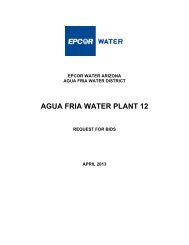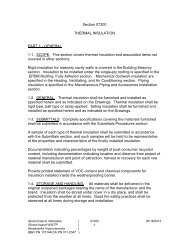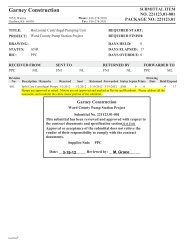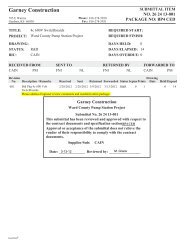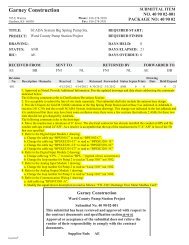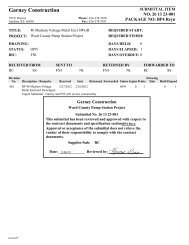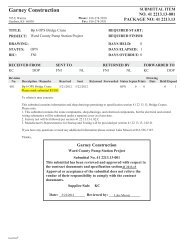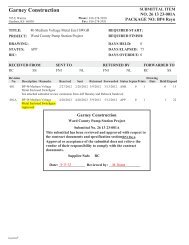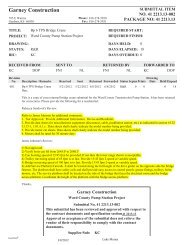33 12 16.26 - 001-A - Butterfly Valves - Garney Construction
33 12 16.26 - 001-A - Butterfly Valves - Garney Construction
33 12 16.26 - 001-A - Butterfly Valves - Garney Construction
You also want an ePaper? Increase the reach of your titles
YUMPU automatically turns print PDFs into web optimized ePapers that Google loves.
1<br />
Health and Safety<br />
2<br />
This manual is produced to enable a<br />
competent user to install, operate,<br />
adjust and inspect Rotork IQ range<br />
valve actuators.<br />
The electrical installation, maintenance<br />
and use of these actuators should be<br />
carried out in accordance with the<br />
National Legislation and Statutory<br />
Provisions relating to the safe use of<br />
this equipment, applicable to the site of<br />
installation.<br />
For the UK: Electricity at Work<br />
Regulations 1989 and the guidance<br />
given in the applicable edition of the<br />
“IEE Wiring Regulations’’ should be<br />
applied. Also the user should be fully<br />
aware of his duties under the Health<br />
and Safety Act 1974.<br />
For the USA: NFPA70, National Electrical<br />
Code ® is applicable.<br />
The mechanical installation should be<br />
carried out as outlined in the manual<br />
and also in accordance with relevant<br />
standards such as British Standard<br />
Codes of Practice. If the actuator has<br />
nameplates indicating that it is suitable<br />
for installation in Hazardous Gas Areas<br />
then the actuator is suitable for use in<br />
Zone 1 and Zone 2 (or Div 1 and Div 2)<br />
explosive atmospheres only. It should<br />
not be installed in atmospheres where<br />
gases are present with an ignition<br />
temperature less than 135°C, unless<br />
suitability for lower ignition<br />
temperatures has been indicated on the<br />
actuator nameplate.<br />
Any test instruments applied to the<br />
actuator should be of equivalent<br />
certification. The electrical installation,<br />
maintenance and the use of the<br />
actuator should be carried out in<br />
accordance with the code of practice<br />
relevant for that particular Hazardous<br />
Gas Area certification.<br />
No inspection or repair should be<br />
undertaken unless it conforms to the<br />
specific Hazardous Gas Area<br />
certification requirements. Under no<br />
circumstances should any modification<br />
or alteration be carried out on the<br />
actuator as this could invalidate the<br />
conditions under which its certification<br />
was granted.<br />
Access to live electrical conductors is<br />
forbidden in the hazardous area unless<br />
this is done under a special permit to<br />
work, otherwise all power should be<br />
isolated and the actuator moved to a<br />
non-hazardous area for repair or<br />
attention.<br />
Only persons competent by virtue of<br />
their training or experience should be<br />
allowed to install, maintain and repair<br />
Rotork actuators. Work undertaken<br />
must be carried out in accordance with<br />
instructions in the manual. The user<br />
and those persons working on this<br />
equipment should be familiar with their<br />
responsibilities under any statutory<br />
provisions relating to the Health and<br />
Safety of their workplace.<br />
WARNING:<br />
Motor Temperature<br />
With excessive use the motor surface<br />
temperature could reach 132ºC (270ºF).<br />
Thermostat Bypass<br />
If the actuator is configured to bypass<br />
the motor thermostat, when using the<br />
ESD function, the hazardous area<br />
certification will be invalidated.<br />
Control and Indication<br />
Where the actuator build allows remote<br />
control and indication supplies higher<br />
than 150V a.c. but below 300V a.c.<br />
(refer to actuator wiring diagram) the<br />
remote control and indication supplies<br />
must be derived from a supply which is<br />
designated as installation category<br />
(overvoltage category) ll as defined in<br />
BSEN 61010 (Safety Requirements For<br />
Electrical Equipment for measurement,<br />
control and laboratory use).<br />
Enclosure Materials<br />
IQ10 to IQ35 are manufactured from<br />
aluminium alloy with stainless steel<br />
fasteners and the thrust bases are<br />
manufactured in cast iron. IQ40 to IQ95<br />
enclosures are manufactured in<br />
aluminium alloy and cast iron with<br />
stainless steel fasteners and the thrust<br />
bases are manufactured in cast iron.<br />
The user must ensure that the<br />
operating environment and any<br />
materials surrounding the actuator<br />
cannot lead to a reduction in the safe<br />
use of, or the protection afforded by,<br />
the actuator. Where appropriate the<br />
user must ensure the actuator is<br />
suitably protected against it’s operating<br />
environment.<br />
Should further information and<br />
guidance relating to the safe use of the<br />
Rotork IQ range of actuators be<br />
required, it will be provided on request.<br />
WARNING: Operating by Hand<br />
With respect to handwheel operation<br />
of Rotork electric actuators, see<br />
warning on p3.



